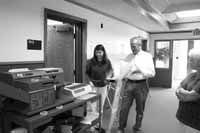| Brenda Dugmore, senior deputy clerk/auditor and Bruce Funk, clerk/auditor, are ready for election day. |
As voters file in to cast their vote on election day many may be unaware of the details involved in making an election happen. Every aspect of the election is covered in the law for whichever types of ballots are used. The paper ballot was used in Emery County prior to 1996. The punch card ballot is used primarily throughout Utah. The optically scanned ballot and equipment is used in Emery County. One of the many questions asked of the county clerk/auditor is why on the current ballot for Emery County, is the Republican candidate the first position in each of the races?
“The law is quiet on this issue and so it is left up to the county clerk. In my case I have elected to use the formula the law spells out in determining which party is majority and minority in each voting precinct. The party having the greatest number of votes in those designated state offices receive the first position on the ballot,” said Bruce Funk, Emery County Clerk/Auditor.
Candidates who file for a county office are required to pay a fee based on the salary they would receive during their four year term of office. Certain offices require that the candidate meet qualifications prior to acceptance of the filing fee, which is non-refundable. A write-in candidate must meet any office requirements plus pay the fee. The difference in a write-in candidate is that their name is not placed on the ballot and the election judges are not allowed to advise voters of any write-in candidates. Finance reports over the years show local candidates can spend more than $4,000 in the more heated races.
The Clerk/Auditor’s office prepares the ballot for printing, orders supplies, and trains the Judges of Election in their responsibilities and duties. A number of required legal notices are placed in the paper starting in February.
From the party caucus names are submitted to be considered as Judges of Elections. Within certain time frames these names are approved by the county commission and the remaining openings are filled by the county clerk. All judges are required to attend a training. “These Judges of Election are some of the greatest people I have worked with over the years. Election day is a long and tiring, usually 15-18 hours, for which judges are compensated $60. Our office puts everything together but it’s the judges that make it happen,” Funk said.
“Our office will handle almost 200 absent voter ballots which are voted in our office or mailed. All absent voter ballots received by our office through election day will be included in the totals that night,” Funk said. Absent voter ballots not received by this time have until noon Nov. 19, 2002 when they will be counted in the election canvass that day and the voting results are made official. Those ballots to be considered in the canvass must be clearly postmarked Nov. 4, 2002.
In 1996 Emery County was the first county to go to an optically scanned ballot while most other counties in Utah were using the punch card system. Those counties using the punch card system must replace their equipment by the year 2006 which will cost millions statewide. On the optically scanned ballot, the voter fills in the oval next to the candidate or position of choice. The main central counting machine is located in the courthouse. It optically reads each ballot. Eleven of the twelve precincts bring their ballots to the courthouse to be read. The ballot boxes have numbered security seals locking the boxes for transport. The ballot boxes are picked up at each precinct and delivered to the courthouse by sheriff deputies or other election officials. The one exception is Green River which has their own precinct counter. The precinct counter at the end of the voting day gives a printout on all races which is then phoned to the Clerk/Auditor’s office. The accuracy of both machines is verified a number of times using a test set of ballots whose results are compared to the manufacturer tests of the same ballots.
Counting of the ballots is done in the foyer of the courthouse in full view of the public. Election results are posted as each precinct is counted. Results are sent immediately to Channel 26 and posted on our website (www.emerycounty.com/election). There are an additional three judges serving as the Resolution Board who work independently in another room to check and prepare the by-mail absent voter ballots for counting.
This board also replaces damaged or unreadable ballots with replacement ballots by assigning serial numbers to both ballots for tracking purposes.
“There is much more that goes into this or any election, but what stands out in my mind is the dedication of all the people involved to make sure everything possible is done to make the election process proceed smoothly for you the voter of this county,” Funk said.

